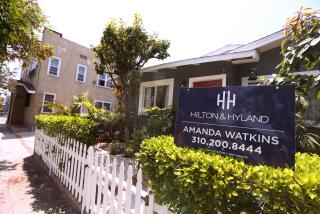A real estate bust would boost L.A.
FOR THE LAST five years, speculators, big developers and homeowners have gorged on Los Angeles real estate. The huge run-up in prices -- more than 135% from 2001 to 2006 -- has greatly increased the spending power of property owners. Yet there has been a worrisome consequence: Working and middle-class families are moving out -- and failing to move in -- because they cannot afford a house here. Long term, that’s not good for the local economy. As perverse as it sounds, what L.A. needs now is a real estate bust.
Recent history is illustrative here. The big and rapid declines in property values in the early 1990s, after the last real estate bubble popped, helped open the door to homeownership for a new generation, many of them immigrants. New owners of delinquent or moribund commercial properties, especially downtown, fueled a spike in business activity, much of it stemming from immigrant and minority entrepreneurship.
This time, the L.A. real estate bubble is more likely to deflate gradually than burst. Unlike in the early 1990s, the local economy is not tanking. Since 2000, job creation and income growth have kept pace with the national averages. But home prices have clearly shot up faster than the economy would justify. They have surged 20% higher here than in such economically booming cities as Las Vegas, Phoenix and Reno. L.A. housing costs have risen twice as high as in Portland, Ore., and Seattle and four times as high as in Dallas, Houston and Atlanta.
The biggest losers have been middle-class families looking to buy a house in greater L.A.. By last year, less than 15% of L.A. families could afford to buy a median-priced home of about $500,000 -- compared with about 50% for home buyers in the rest of the country. Not surprisingly, this has accelerated the movement of working and middle-class families to more affordable regions.
One indication of middle-class flight is the rate at which people with bachelor’s degrees and higher are leaving Los Angeles. According to the most recent community survey from the U.S. census, such people are moving out at a higher rate than in the late 1990s. From 1995 to 2000, for instance, a net 28,000 people with bachelor’s degrees and higher moved out of Los Angeles and Orange counties. In 2004-05, the rate of exodus was almost twice as high.
This isn’t to say that Los Angeles can’t draw some of the world’s most talented people. Those at the top -- or aiming for it -- of the employment pyramid in entertainment, finance and technology can either afford housing at any price or will sacrifice homeownership, at least for a while, for career reasons. And with its great climate, cultural assets and cache, wealthy people will live or at least own a house here.
But high-end buyers and elite workers alone cannot sustain large-scale economies. Most companies require a broad range of workers, from highly skilled tradespeople to technicians and middle managers. These are the workers, especially if they live elsewhere or don’t own a home here, whom executives frequently complain are difficult to recruit or retain in Southern California.
When executives find their employees cannot afford houses in an area, they often move their companies to where they can. Nissan and Countrywide, for instance, have announced plans to shift operations or expand in less-expensive areas.
Until the last few years, the Inland Empire offered a viable alternative for workers seeking to buy a home and executives looking to build a workforce. In the early 2000s, the area enjoyed steady growth in such higher-wage sectors as business and professional services, averaging about 5% annually. More upwardly mobile families were moving in than out. By contrast, growth in these high-wage sectors was barely 1% in more expensive Los Angeles and Orange counties combined.
By 2005, however, rising home prices in the Inland Empire threatened even this middle-class bastion. Since then, prices have begun to drop and home inventories to swell, two positive developments that may make the region more affordable for middle- and working-class home buyers.
One promising sign is that entry-level homes are coming back in fashion. “It’s all about the middle-income buyer again,” said Mark Dowling, vice president of De Oro Property, an Ontario-based company that builds houses in areas that are already developed. “The middle-range demand is more elastic. If you offer a good product at $400,000, you will sell it.”
A similar move back to the middle-market buyer would be a strong positive for the pricier coastal areas as well. Demand for the multimillion-dollar mini-mansions -- the signature property of the millennium -- seems to be weakening. So far, sales trends in Los Angeles and Orange counties show prices holding up far better in such affordable cities as Carson and Inglewood than in more expensive Beverly Hills and Rancho Palos Verdes. The new “stars” of real estate are now flavored plain vanilla.
A real estate bust or severe price correction could also rescue L.A.’s inner-city revival, including downtown. Contrary to the hype of the condo market, a new study from the Research Institute for Housing America shows that only a small percentage of baby boomers are moving back to the city. Many more either stay in the suburbs or move farther into the hinterland. These were the people, along with foreign buyers and speculators, who were supposed to be the bulk of buyers in the high-end urban condo market.
This helps explain why between 10 to 14 condo developments downtown -- and similar projects in other cities -- have been mothballed or downsized. Yet here too, the bad news may prove to be good news. Lower condo prices might renew the attraction of the inner city for those -- singles, young childless couples and artists -- who started the back-to-downtown movement.
Even a modest real estate bust, of course, would not please speculators, politically connected developers and homeowners whose paper profits have driven some excessive spending. But in the larger scheme of things, who cares outside of BMW dealers or McMansion builders? After all, a little Schumpeterian “creative destruction” at the expense of luxury builders and speculators may be a good thing -- particularly if it creates new housing opportunities for the region’s middle class and new reasons for business to stay or expand in L.A.
More to Read
Inside the business of entertainment
The Wide Shot brings you news, analysis and insights on everything from streaming wars to production — and what it all means for the future.
You may occasionally receive promotional content from the Los Angeles Times.










